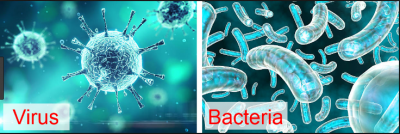
The word microorganism or microbe may make many of us think of bacteria and virus. But did you know that technically a virus is not even a living organism? So that makes it very different from bacteria. Come, let’s find out what the differences between the two are.
Bacteria are tiny one-celled organisms. These microorganisms come in a variety of shapes from spheres and rods to spirals. They are found in almost all the places on our planet-from soil and rocks to oceans and snow. Some species thrive even under extreme conditions. They are very important for keeping ecosystems going. Why, even our bodies have bacteria both inside and outside! They are found on our skin and in our gut. Most bacteria in the body are harmless, and some are even helpful. For instance, the bacteria in our gut help break down food and keep us healthy. But a relatively small number of bacteria can also cause diseases, some of which can lead to death. Among such diseases are the plague, tuberculosis, and cholera. Antibiotics are used to treat bacterial infection.
Unlike bacteria, a virus is not made up of any living cell. It is just a genetic code – either RNA or DNA-encased in a coat of protein. For a virus to multiply, it requires a host cell-for instance, cells in a human body. Once they find host cells, the viruses multiply, in the process infecting (sometimes killing) host cells. Just like bacteria, viruses too are found almost everywhere. But studies have shown that there are more viruses than bacteria. Since they are also different from bacteria, they cannot be killed using antibiotics. Vaccines and anti-viral medications help eliminate or decrease the severity of viral infections. Many of the diseases that have affected humans globally have been caused by viruses-from small pox and AIDS to measles and the on-going COVID-19 pandemic.
Picture Credit : Google
Leave a Reply